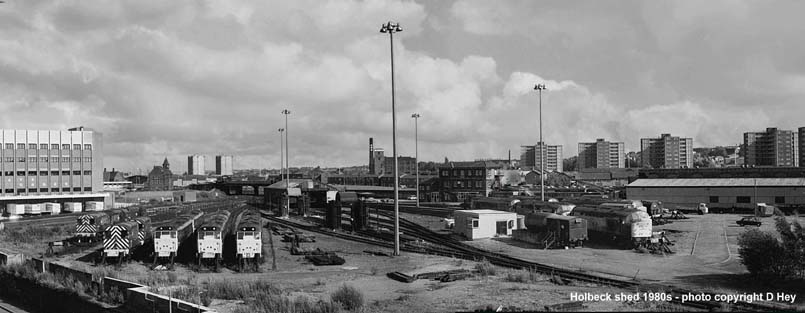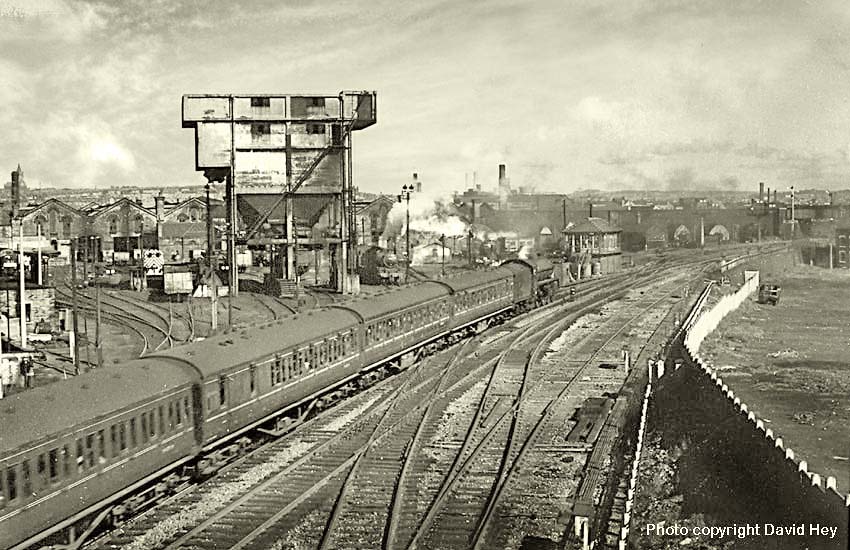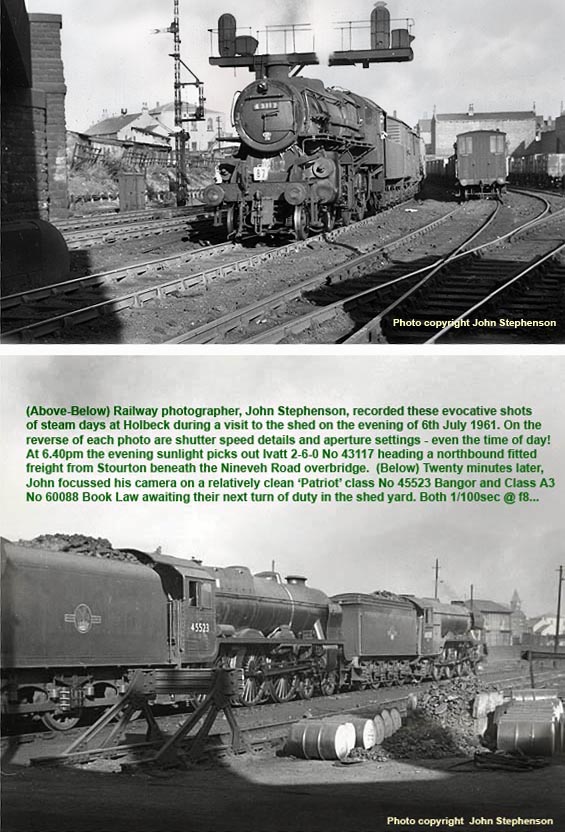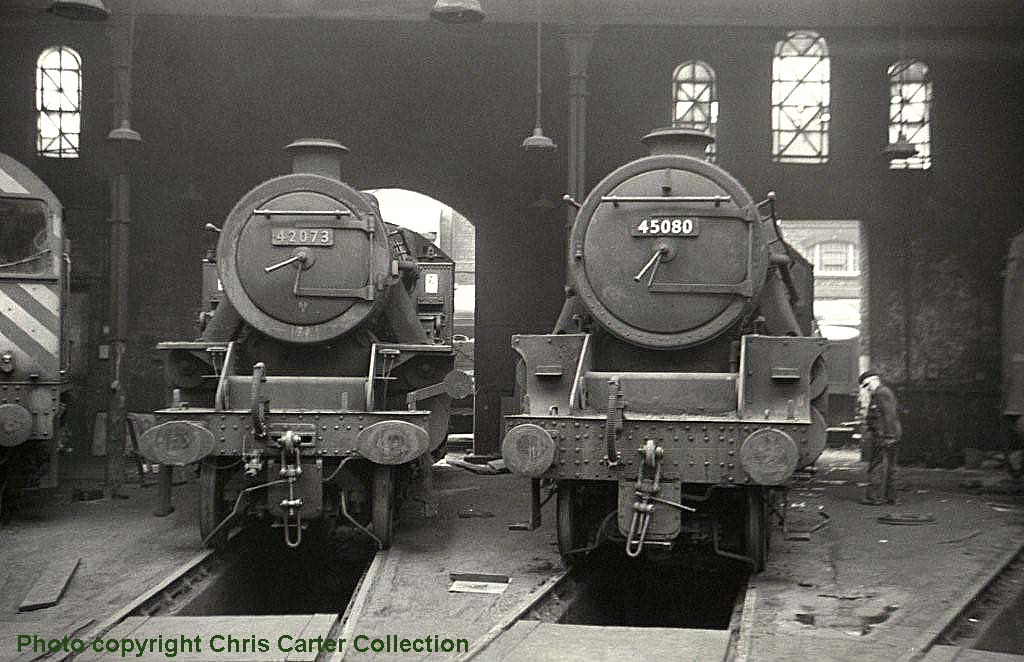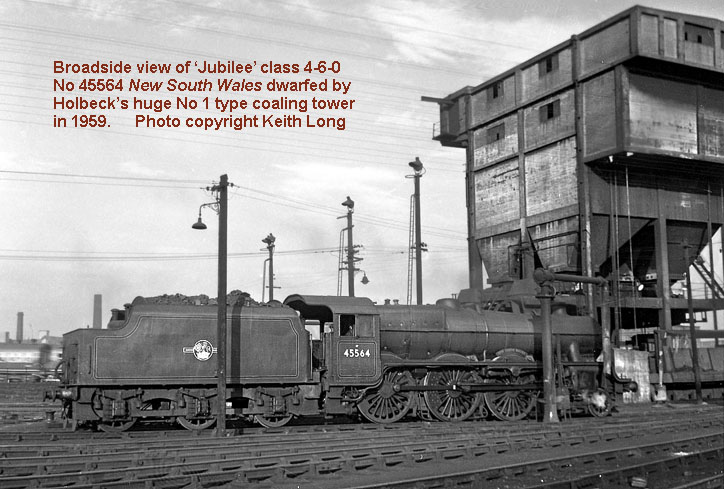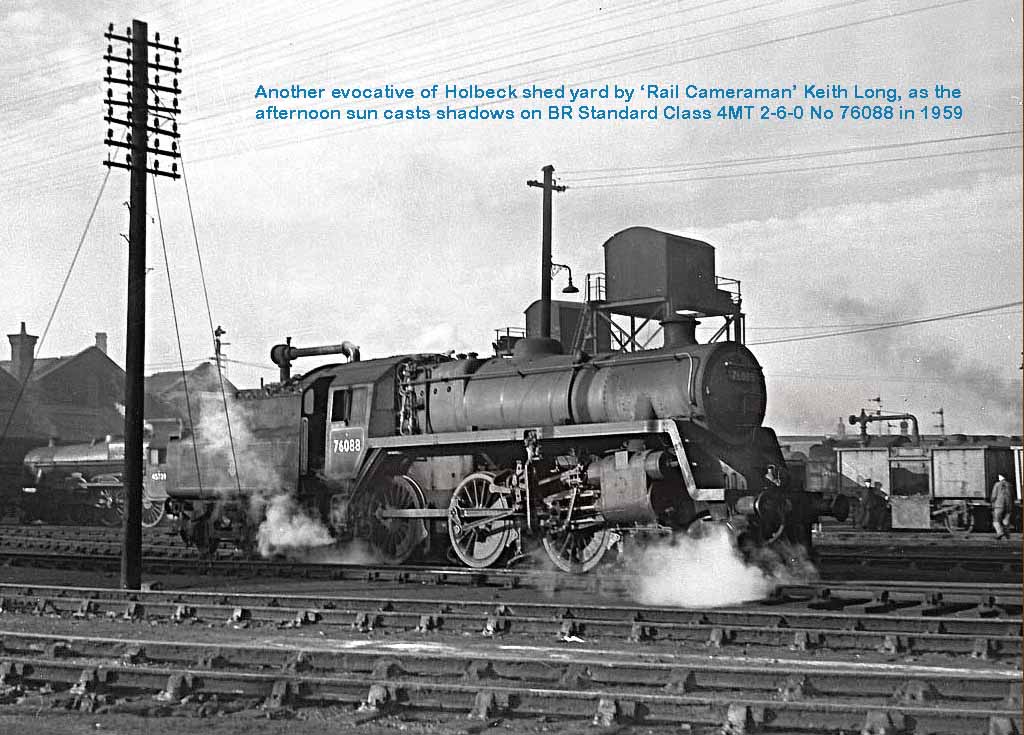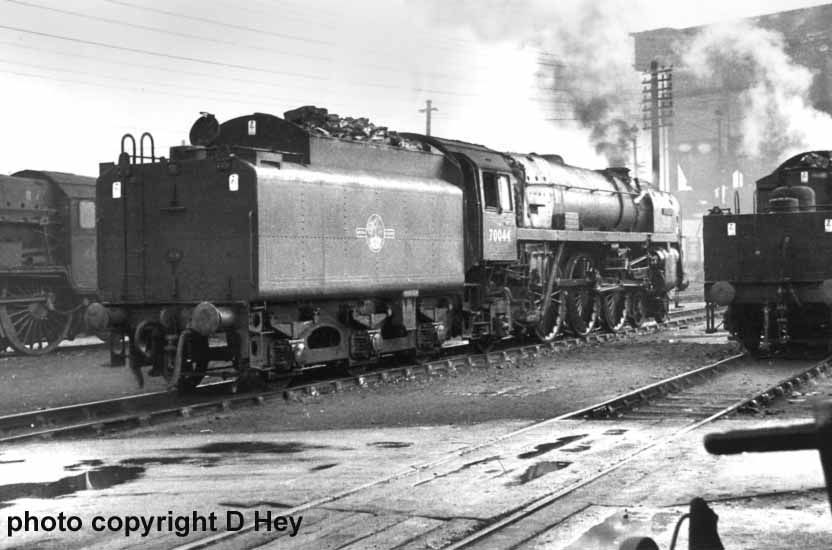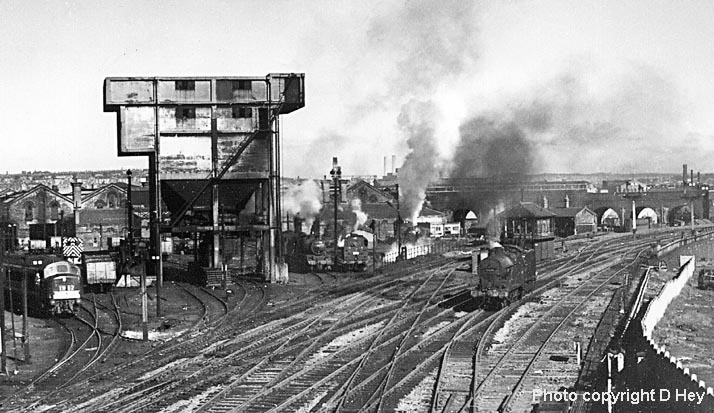BONZO BOWS OUT DISGRACEFULLY
Back in the 1950s my spotting pal, Bonzo (see 'Crewe' page) was the only person who could have persuaded me to risk life and limb plus other unmentionables as we scaled perimeter walls (embedded with broken glass) to gain unlawful entry in to engine sheds. They called it 'bunking' - today's equivalent of shed bashing - which, apart from the occasional foray into petty villainy on Mischief Night, was the closest I ever came to juvenile delinquency.
With hindsight, our behaviour was more impish than evil - something of a jolly jape, if you like - yet the blatant way we trespassed on railway property was no less disconcerting for that. Out of all the sheds we visited in the Leeds area, the main target on our agenda was the London Midland Region's motive power depot at Holbeck. The shed was formerly shed-coded 20A, until it came under the auspices of the North Eastern Region in 1957, and it was subsequently re-coded 55A, along with its sub-depots bearing suffixes B-G in the regional reshuffle. There was something 'spiritual' about Holbeck, though from the outside it was a forlorn-looking building dwarfed by a huge concrete coaling tower that stood like a monument in the shed yard. But the shed's inner sanctum was a different story - a standard Midland Railway 'square' roundhouse containing two turntables, each with radiating stalls chock-full of engines standing cheek to jowl like a herd of thirsty hippos around a watering hole. The air was usually heavy with smoke, hot oil and steam, which somehow gave the cathedral of steam a wonderful sense that everything had gradually evolved; certainly it had none of the instant mix-and-match that came with the headlong rush to dieselisation in the Sixties...continued below.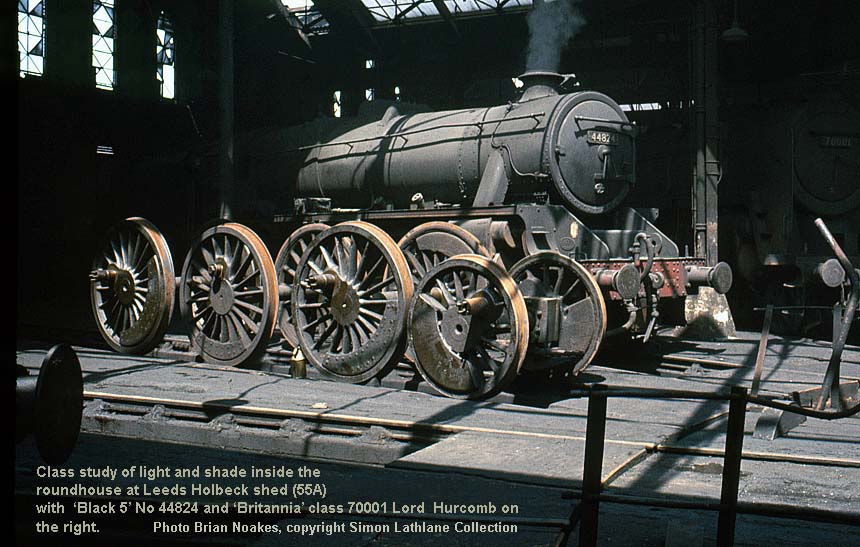
 The only means of gaining entry to Holbeck - and escape, for that matter - was by climbing through the cast iron window frames at the back, a hazardous scramble for anyone shorter than twelve foot-six, but the rules of engagement were simple - speed and military precision - because if a bunk was carried out with lightning speed, then the element of surprise usually tipped the balance in our favour over the beleaguered shed staff.
The only means of gaining entry to Holbeck - and escape, for that matter - was by climbing through the cast iron window frames at the back, a hazardous scramble for anyone shorter than twelve foot-six, but the rules of engagement were simple - speed and military precision - because if a bunk was carried out with lightning speed, then the element of surprise usually tipped the balance in our favour over the beleaguered shed staff.
As for the rest of the bunks we did? In every place we visited, the sheds were usually hidden among the maze of inner-city Victorian back streets, where the local women gossiped over back yard walls and children played in cobbled streets, lined by rows of terraced houses boasting spotlessly clean doorsteps painted in red cardinal polish. I was still a naïve youngster in short pants, so the dingy back alleys could be scary places to walk alone, for just around the next corner existed an omnipresent danger of stumbling into a multi-cultural community where the residents wandered around in clothes that looked suspiciously like pajamas to me, and in my youthful imagination - a neurotic obsession with flesh-eating cannibals - the awful fear arose that if I lingered too long I might end up in a cooking pot. A mere glance from a black face was sufficient to cause long bouts of involuntary flatulence: a condition brought on by one's nerves going out of kilter. (continued below)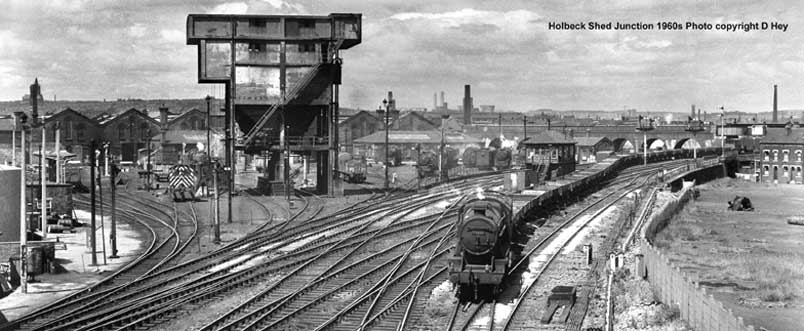
(Above-Below) The view from Nineveh Road overlooking Holbeck shed yard was a popular venue for weekend spotters in steam days. The shed (20A) came under the auspices of the North Eastern Region in 1957 and was subsequently re-coded 55A, along with its sub-depots bearing suffixes B-G in the regional  reshuffle. Here, Class 8F No 48083 trundles empty flat wagons through Engine Shed Junction towards Stourton. In the shed yard, Stanier 'Black Fives' are accompanied by a pair of Class 25 diesels and a solitary Class 03 diesel shunter with its distinctive striped cab. The shed closed its doors to steam on September 30th 1967 and the buildings and No 1 type concrete coaling tower was demolished in 1970 - the structure had two bunkers that could hold 300 tons of coal and was able to service two engines at a time. More close-up views of the shed yard can be found on the Railway Modellers' page 19. (Below) This view was taken from the former LNW viaduct on 6th July 1982 during an ASLEF dispute. The scene shows the fuelling point (built on the site of the coaling stage) and the diesel maintenance depot (on the extreme right) containing two repair shops with 200ft tracks and a large overhead crane. In the foreground, a variety of diesel locomotives, including Class 08s, 31s, 40s and 45 'Peaks' - it's a far cry from shed's allocation of famous steam classes, which included 'Claughtons', unrebuilt 'Patriots', Stanier 'Jubilees' and rebuilt 'Scots', BR Standard 'Britannias' and Gresley A3s. Sadly, all are now but just a memory.
reshuffle. Here, Class 8F No 48083 trundles empty flat wagons through Engine Shed Junction towards Stourton. In the shed yard, Stanier 'Black Fives' are accompanied by a pair of Class 25 diesels and a solitary Class 03 diesel shunter with its distinctive striped cab. The shed closed its doors to steam on September 30th 1967 and the buildings and No 1 type concrete coaling tower was demolished in 1970 - the structure had two bunkers that could hold 300 tons of coal and was able to service two engines at a time. More close-up views of the shed yard can be found on the Railway Modellers' page 19. (Below) This view was taken from the former LNW viaduct on 6th July 1982 during an ASLEF dispute. The scene shows the fuelling point (built on the site of the coaling stage) and the diesel maintenance depot (on the extreme right) containing two repair shops with 200ft tracks and a large overhead crane. In the foreground, a variety of diesel locomotives, including Class 08s, 31s, 40s and 45 'Peaks' - it's a far cry from shed's allocation of famous steam classes, which included 'Claughtons', unrebuilt 'Patriots', Stanier 'Jubilees' and rebuilt 'Scots', BR Standard 'Britannias' and Gresley A3s. Sadly, all are now but just a memory.
I wouldn't have dared 'bunk' a shed without Bonzo. Not only was he two years older than me, the success of our spotting trips was all down to his organizational skills. He had an uncanny knack of following the street directions in his well-thumbed edition of Aidan Fuller's 'British Locomotive Shed Directory'. But his 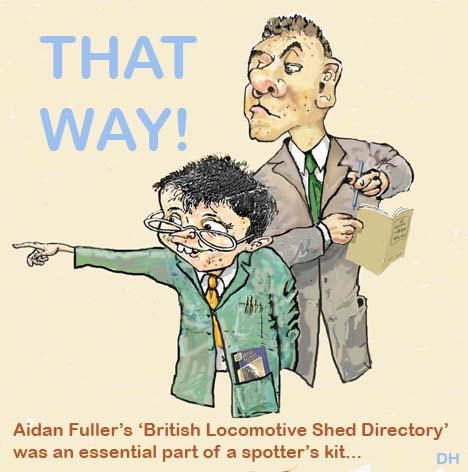 biggest fault, if I had to find one, is that he liked to lead from the rear. On almost every bunk we did, I started panicking at the sight of the target shed still some distance away, but the fear factor barely registered with Bonzo until the very last second. Then, just as we were about to go in, he lost his bottle - and, come to think of it, I led the way every time...
biggest fault, if I had to find one, is that he liked to lead from the rear. On almost every bunk we did, I started panicking at the sight of the target shed still some distance away, but the fear factor barely registered with Bonzo until the very last second. Then, just as we were about to go in, he lost his bottle - and, come to think of it, I led the way every time...
'You go first,' he'd say in a querulous squeak.
'Why me?' I asked.
'Because I bags go last,' he insisted, 'It's daft us both getting caught...'
I could always tell when Bonzo was nervous - he was letting me go first? What he really meant, of course is, if anyone was going to get caught, then it wasn't going to be him. Oh, such a cool-dude - out to save his own neck every time. But one day, he did get caught. I was there when it happened. Call it a spotter's sixth sense if you like, but for some reason the idea of bunking Holbeck didn't seem right that day. Inside the roundhouse, the engines wheezed smoke and hissed steam, but I heard none of it. With an intensity that blocked out every other sound, I had a strange feeling that someone was watching us - 'I'm not going in,' I said adamantly...
'You scaredy-cat!' he sneered, and hauled himself through the broken window.
What happened next...was, well - creepy. First I heard running, then a man's voice called out - 'Hey you! Come 'ere, yer little bugger…' I heard a scuffle, a low-voiced murmur, then Bonzo started whimpering - 'Who me? I didn't break any windows. No Sir, it was broken already. What was I doing? Well, I was...I was sort of...I was…'
At that point, his voice tapered off into helpless stammering.
And what did I do?
I did what anyone else  would have done in the circumstances...
would have done in the circumstances...
I ran like the clappers…
I raced through the streets of Holbeck like a headless chicken until I reached our prearranged meeting place under the railway bridge on Globe Road. An hour later, a sheepish Bonzo turned up nursing a couple of bruises. The one on his arm looked suspiciously like a Chinese burn to me, but Bonzo was soon back to his old nonchalant-self - 'Me get caught?' he said with typical aplomb - 'You've got be kidding. I gave 'im the slip.'
Really? It sounded more like unconditional surrender to me, but I hadn't the nerve to tell him. For weeks afterwards he sported his bruises like battle honours - and, believe it or not, he actually meant it, smug sod - and not for the first time, I realised what an absurdly inflated opinion he had of himself...
As it turned out, that was the last time we went train spotting together, because Bonzo changed from being an indomitable self-confident 'Fonz'-type character into an irascible, boorish teenager with greasy hair, introspective mood swings and his voice broke into a manful 'oink'. He left school and got a job as a conductor on the buses, and I rarely saw him again, thank goodness!...I say thank goodness, because he had obviously outgrown me, which, with hindsight, I had seen coming for quite some time. Being two years his junior made all the difference at that age.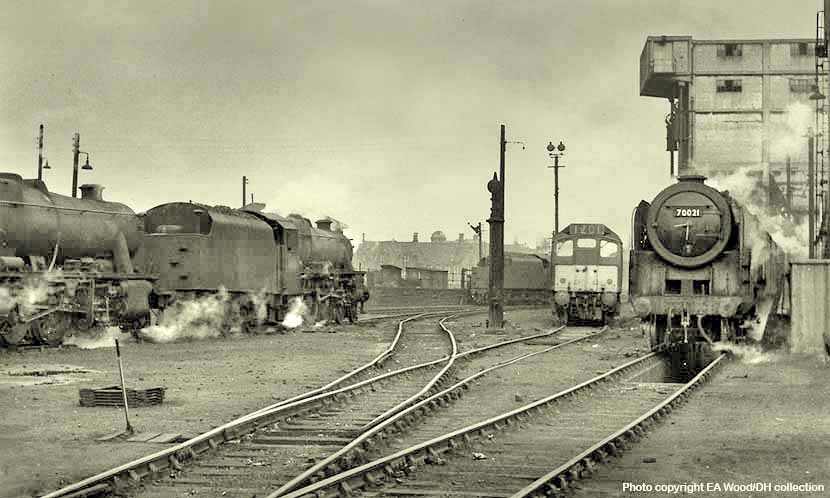
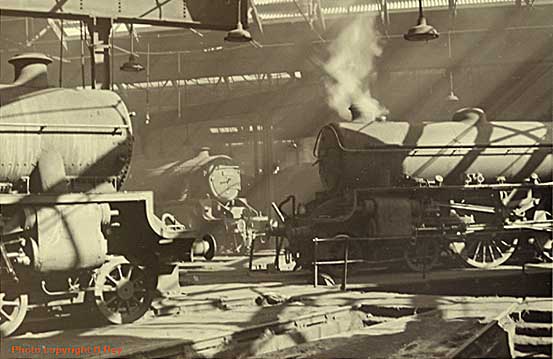
(Above-Below) Light and shade streams through the roof of the roundhouse as a Class B1 moves off the turntable in June 1962. (Below) Colour photographs of old steam days are quite rare. Although most railway photographers dabbled with colour film at one time or another, the majority abandoned the idea of using it regularly because of disappointing results. In those days, colour shots had to be taken on very slow film by modern standards, requiring long exposures. And film was not cheap, which is why many photographers stuck with black & white film. Back in the 1960s, Bill Wright opted for using Kodachrome 11 film whenever possible. The colour rendition of Kodak was always very good, with hardly any graining. Sometimes he used Kodachrome X for the higher speed, but this was more grainy and had a slight purple hue to it. He did try Agfa film once but didn't like it at all. I've selected fIVE of Bill's beautiful studies of Holbeck's murky interior - more of Bill's colour shots can be found on Page 57. Also a link is provided to his superbFlickr site. Photos © D Hey and Bill Wright.

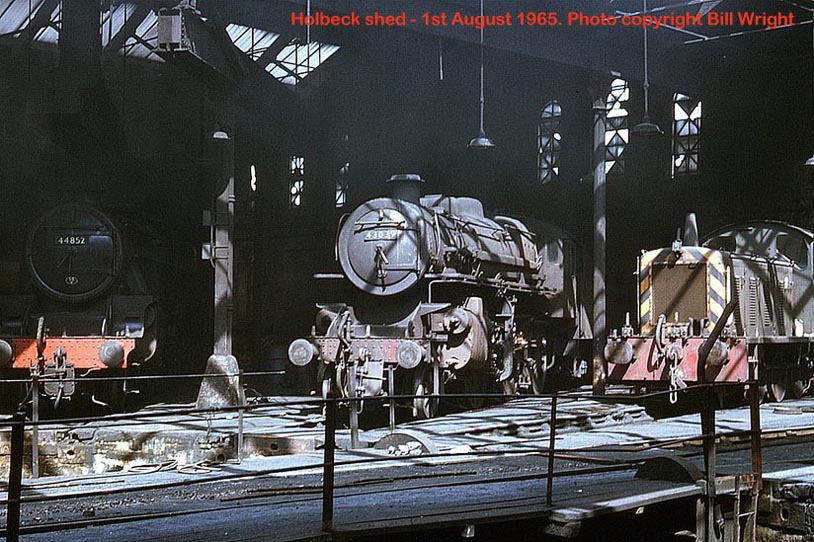

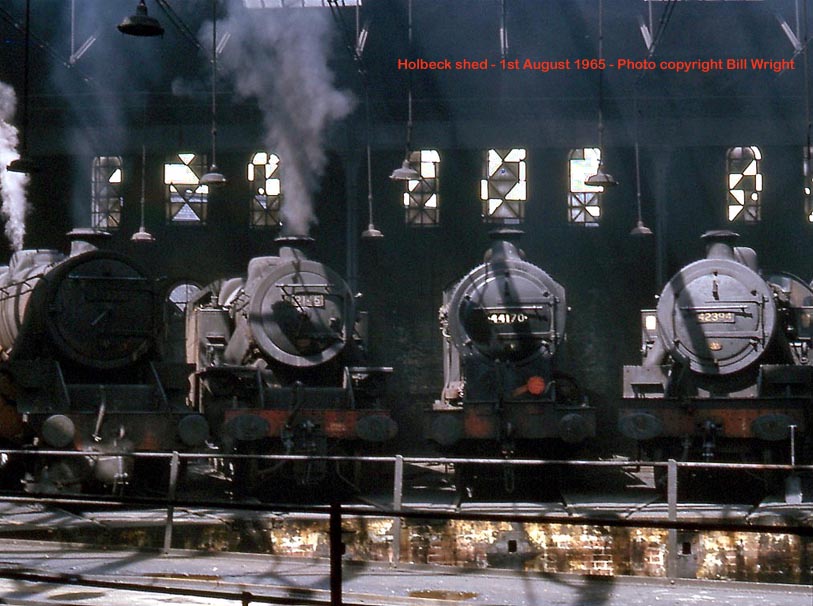
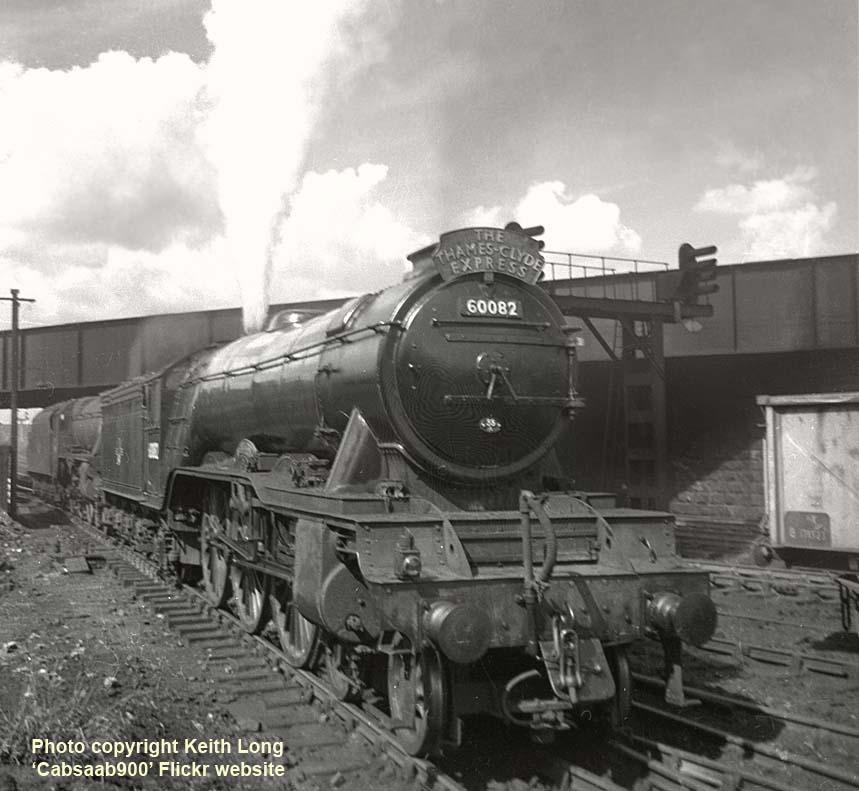
(Above) Another excellent shot from Keith Long's 'Cabsaab900' Flickr Photostream, showing Class A3 No 60082 Neil Gow waiting to run from Holbeck shed (55A) to Leeds City station to work the northbound 'Thames-Clyde Express' on 20th August 1960. Now I may be an old softy at heart, but this photo rekindles  many fond memories of old spotting days since it features so many things I recall from childhood, including the three items of railway memorabilia (below) that recently went under the hammer at the famous Great Central Railwayana Auctions. The first is the locomotive headboard, 'The Thames-Clyde Express' (left) as used from 1951 on the Anglo-Scottish service from St Pancras to Glasgow St Enoch over the Settle-Carlisle route. The nameplate measures 40" x 17½" and sold for £3,600 at GCR Auctions on 18th July 2009. (Right) Then there is the 55A shedplate, as used from October 1956 up to the shed closing to steam in October 1967. The back of the plate is marked 'Jan 63, 55A, 45639, Raleigh 14A' and sold for £300. Finally we come to the locomotive's nameplate, 'Neil Gow'. This LNER A1 Class 4-6-2 No 2591 was built by the North British Locomotive Company in November 1924 and later re-classified as an A3 in January
many fond memories of old spotting days since it features so many things I recall from childhood, including the three items of railway memorabilia (below) that recently went under the hammer at the famous Great Central Railwayana Auctions. The first is the locomotive headboard, 'The Thames-Clyde Express' (left) as used from 1951 on the Anglo-Scottish service from St Pancras to Glasgow St Enoch over the Settle-Carlisle route. The nameplate measures 40" x 17½" and sold for £3,600 at GCR Auctions on 18th July 2009. (Right) Then there is the 55A shedplate, as used from October 1956 up to the shed closing to steam in October 1967. The back of the plate is marked 'Jan 63, 55A, 45639, Raleigh 14A' and sold for £300. Finally we come to the locomotive's nameplate, 'Neil Gow'. This LNER A1 Class 4-6-2 No 2591 was built by the North British Locomotive Company in November 1924 and later re-classified as an A3 in January 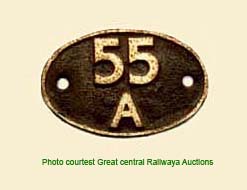 1943. Renumbered 82 in 1946, the loco became 60082 in BR days. The loco was allocated new to Heaton and remained there until moving to Gateshead in 1948. It then alternated between Heaton and Gateshead with brief stays at Darlington and Holbeck sheds. Withdrawn from Gateshead on 2nd September 1963, it was cut up at Darlington Works. One of the great joys of old spotting days is that you're constantly learning new facts; in addition to providing an excellent catalogue, the Great Central Railwayana Auctions feature many interesting facts hitherto unheard of. For example, although 60082 took its name from the racehorse which won the 2000 Guineas in 1910, I now learn that the horse itself was named after a celebrated violin player and composer of traditional Scottish airs (1727-1807) in whose memory the Annual Scottish Fiddle Festival is held at Dunkeld & Birnam close to where he lived. Click here to visit the Great central Railwayan Auction's fascinating website. Footnote: the 'Neil Gow' nameplate sold for £7,600 at the GCR's April 2011 auction.
1943. Renumbered 82 in 1946, the loco became 60082 in BR days. The loco was allocated new to Heaton and remained there until moving to Gateshead in 1948. It then alternated between Heaton and Gateshead with brief stays at Darlington and Holbeck sheds. Withdrawn from Gateshead on 2nd September 1963, it was cut up at Darlington Works. One of the great joys of old spotting days is that you're constantly learning new facts; in addition to providing an excellent catalogue, the Great Central Railwayana Auctions feature many interesting facts hitherto unheard of. For example, although 60082 took its name from the racehorse which won the 2000 Guineas in 1910, I now learn that the horse itself was named after a celebrated violin player and composer of traditional Scottish airs (1727-1807) in whose memory the Annual Scottish Fiddle Festival is held at Dunkeld & Birnam close to where he lived. Click here to visit the Great central Railwayan Auction's fascinating website. Footnote: the 'Neil Gow' nameplate sold for £7,600 at the GCR's April 2011 auction.

(Above-Below) Incompatible bedfellows! A typical scene during the transition from steam shows 'Peak' class No D77 Royal Irish Fusilier and an unidentified 'Black Five' standing side-by-side in the shed yard at Holbeck in March 1965. For the record, 1965 saw the number of main line diesels increase by 353 to 2,811, whereas BR's fleet of steam locomotives was reduced by 1,986 to 2,987. In that same year, 92% of the total coach train miles was operated by diesel and electric traction as against 87% in 1964. (Below) Built at Crewe in 1935, Lot No 121, 'Jubilee' class No 45675 Hardy was withdrawn from traffic at Holbeck shed in June 1967 and stored at Wakefield for four months before being cut up at Cashmores Great Bridge in November 1967. 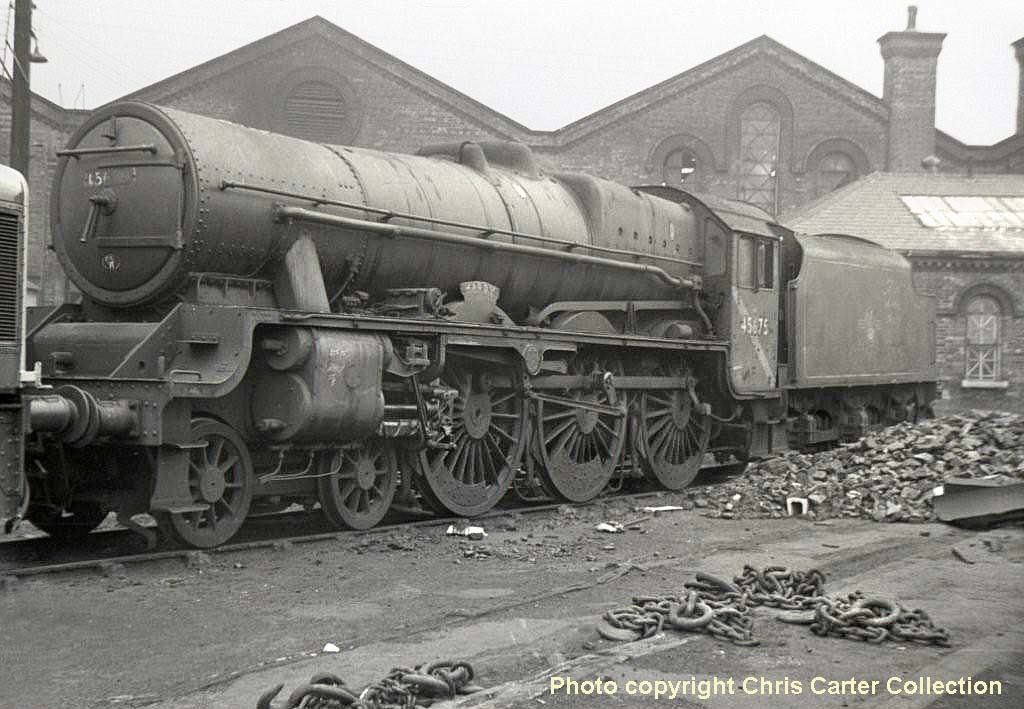
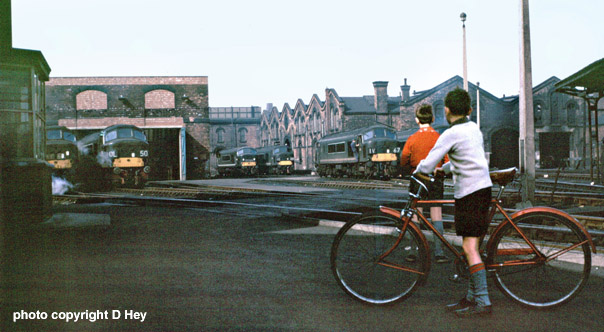
(Above) In the days before Chopper bikes became all the rage, boys rode trusty two-wheelers with saddles fixed way too high for short legs! My records show this shot was taken at 1/60sec @ f8 using a Kodachrome 2 (KR 135 for Daylight) on September 14th 1963, and gives some idea of the diesel facilities on the left, along with the entrance to steam roundhouse on the right. Not long ago a publisher asked if I had a colour shot of 'Peaks' at Holbeck for the front cover of a book, but changed his mind when he saw the boys in the 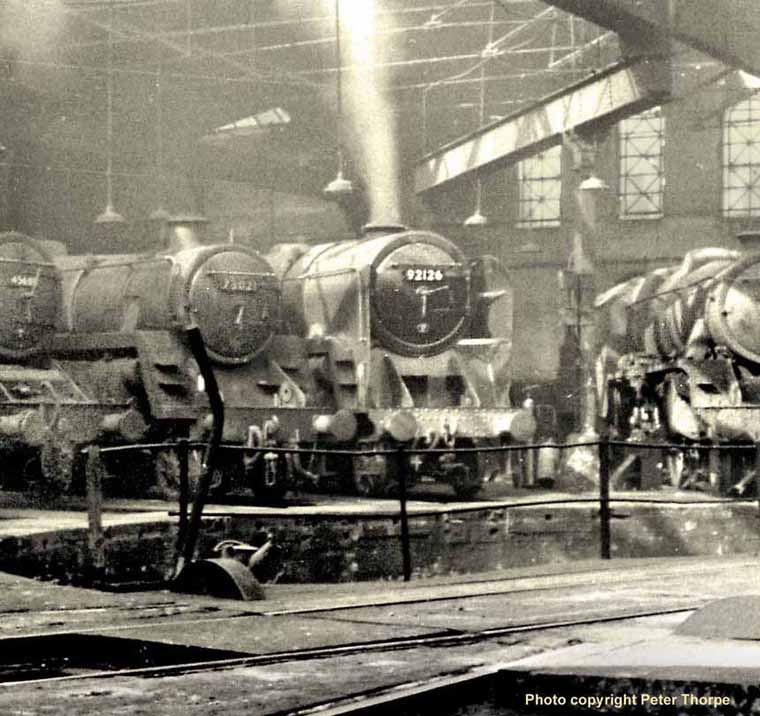 foreground - 'Why didn't you tell them to shift?' he said accusingly - 'They spoil a half-decent picture!' Oh dear, I didn't like telling him that I asked them to stand there! As the saying goes, one man's junk is another man's treasure, and not everyone shares the same view on what constitutes a 'half-decent' photo. Still it's interesting to note the boy's short-back 'n' sides, woolly pullovers, short trousers and knee-length socks (half-rolled down) which was pretty much the fashion for an archetypal train spotter in the early Sixties - the decade didn't start 'swinging' until 1964.
foreground - 'Why didn't you tell them to shift?' he said accusingly - 'They spoil a half-decent picture!' Oh dear, I didn't like telling him that I asked them to stand there! As the saying goes, one man's junk is another man's treasure, and not everyone shares the same view on what constitutes a 'half-decent' photo. Still it's interesting to note the boy's short-back 'n' sides, woolly pullovers, short trousers and knee-length socks (half-rolled down) which was pretty much the fashion for an archetypal train spotter in the early Sixties - the decade didn't start 'swinging' until 1964.
(Below) With 1960s steam showing signs of rapid decline, a young Peter Thorpe (Page 63) set about photographing the scene with frequent weekly visits to Holbeck shed, taking care to go on a Sunday afternoon and early evenings when the sun was in the right place. He no longer needed to bunk the shed; the foreman proved to be most helpful, as long as he advised him when he was on site and informed him when leaving. The foerman seemed to appreciate his interest and explained the workings of a busy mpd, often talking him through the roster board on the wall outside his office just inside the entrance.Taking nothing for granted, Peter always made a point of thanking him each time when leaving. This Kodak Brownie 127 shot of 'Black 5' Nos 44853 was taken on 4 May 1963.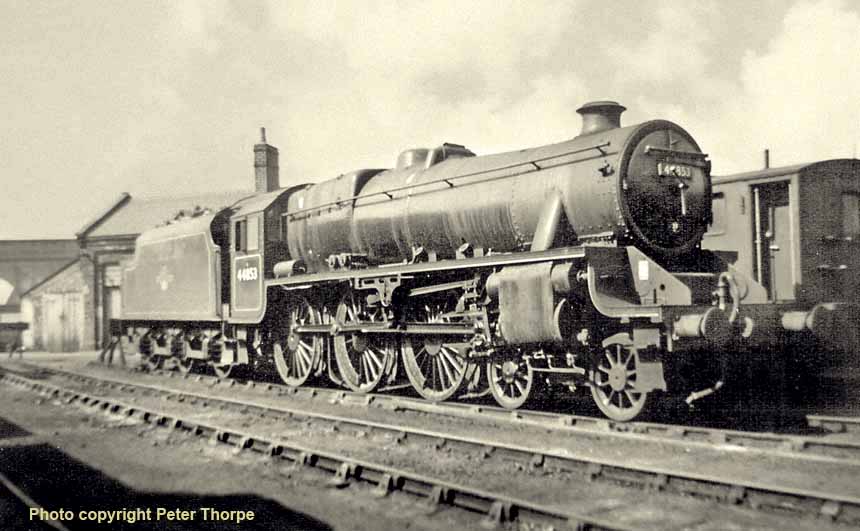
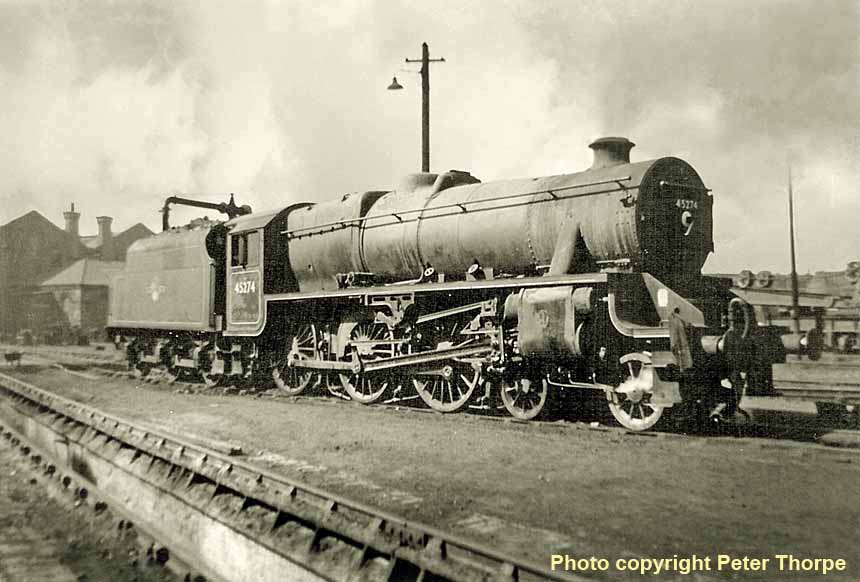
(Above-Below) 'Black 5' No 45274 at Holbeck 55A on 4 May 1963. (Below) Peter Thorpe writes - 'Holbeck had a very large coaling tower and during my visits to the shed in 1963 I lost count of the number of times I asked the foreman's permission to take elevated shots of the shed yard from the top, but his refusal was the inevitable response. Then one day on 30th March 1964, I was both pleased and surprised to be told he would allow it just this once as a reward for my persistence. Needless to say, he went to great lengths to warn me of the dangers of climbing to the top and to make sure of my safety he assigned a fireman to escort me. However the fireman had other ideas; he thought I was mad and stayed put at the base, making sure he was out of view of the shed master's window. As I climbed halfway up the tower a Britannia 70052 Firth Of Tay (67A) backed in to coal up; the noise was deafening - its tender must have been empty - the cloud of coal dust was horrendous and the whole plant seemed to be vibrating. I eventually reached the top, snatched three shots and returned to terra firma, sweating, shaking and absolutely filthy - much to the amusement of the fireman. 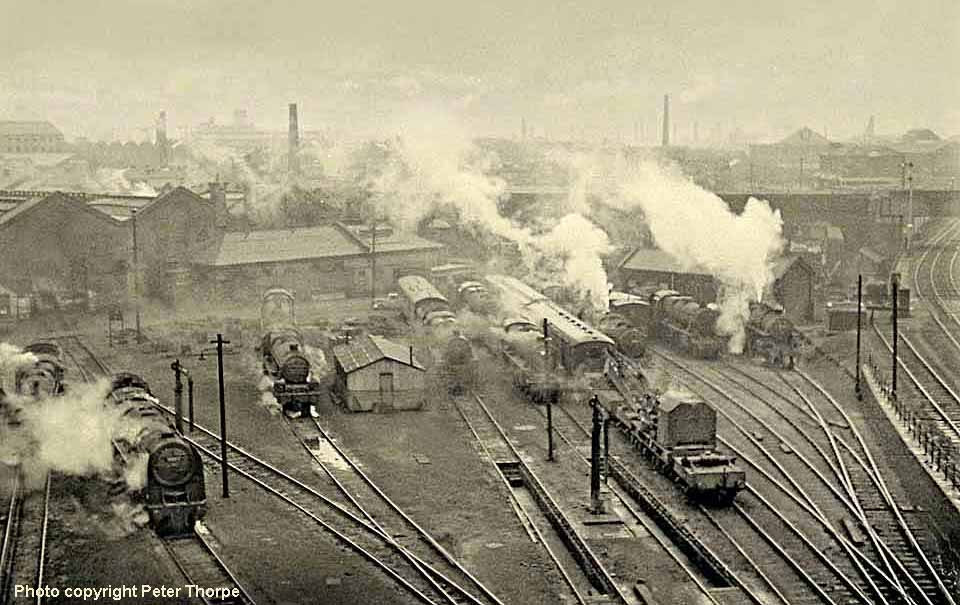
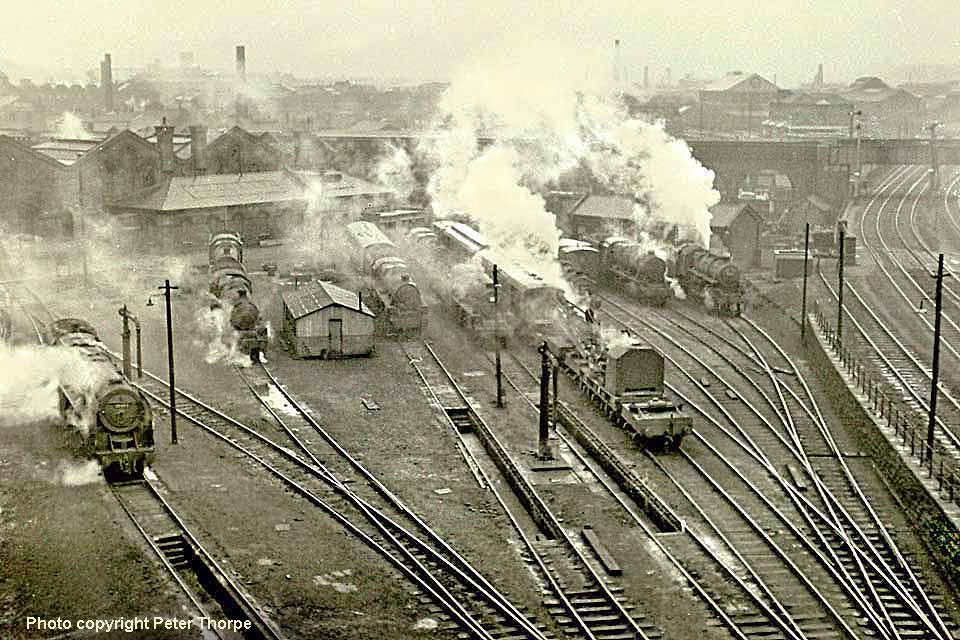
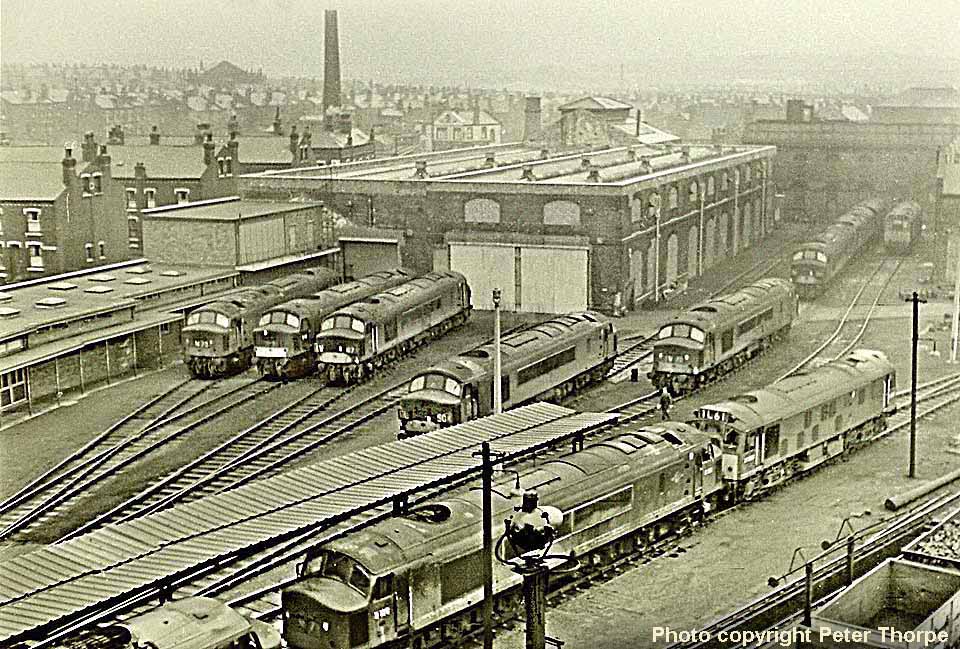
(Above) Peter Thorpe's third elevated shot shows Holbeck's new diesel facilities completed early in 1963 with both 1 and 2 Machine Shops converted to examine, service and repair its diesel allocation which gradually increased towards its intended approx 120 locos. He writes - 'I suspect plenty of overtime was available! On reflection, I remember thinking how lucky I was to be allowed up the coaling tower that day for I had borrowed my work colleague's 35mm camera over the weekend. I also remember the rollicking my parents gave me the next day. Despite sneaking in unnoticed I had left the worst tidemark in the bath you could ever wish to see!' More phtos of Holbeck can be found on Peter's 'Rail Cameraman' page HERE Please note the page is still under construction...
(Below) Back on safe ground this is a more conventional shot he took of 70052 at Holbeck. Built at Crewe Works in August 1954, No70052 operated mostly in Scotland, serving Polmadie MPD (66A) from August 1954 to April 1962; then briefly at Corkerhill shed (67A) before being transferred to Crewe North MPD (5A) in October 1962. Next 70052 found employment at Crewe South shed (5B) between May and September 1965; this was followed by a move (along with seven other Britannias) to Banbury MPD (84C) (ex-GWR) now assigned to the Midland Division and recoded (2D), but this too was a short-lived exercise, as 70052 made its way in January 1966 to Carlisle Kingmoor shed (12A), where it saw out its rather short career being withdrawn from traffic on 1st April 1967.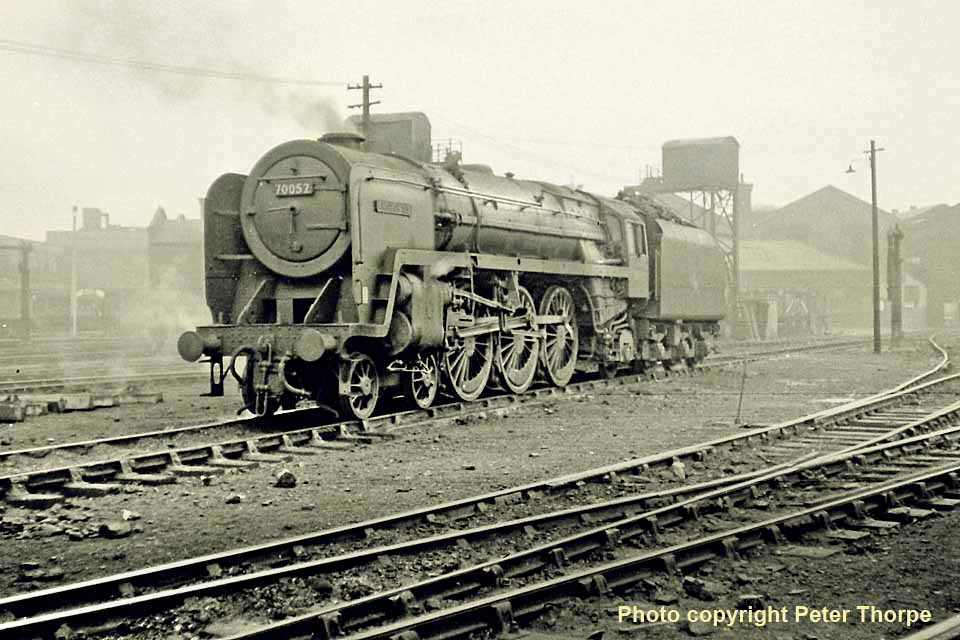
(Below) Fast-forward to 30th September 1967 - the last day of steam at Holbeck - and the shed's celebrity 'Jubilee' class No 45562 Alberta (now sporting the diagonal warning stripe on the cab side indicating the locomotive was not allowed to work on the electrified part of the WCML due to clearance difficulties beneath the overhead catenary) is awaiting its next turn of duty, probably a steam special? Doubtless someone will know Alberta's movements during its final days at Holbeck...
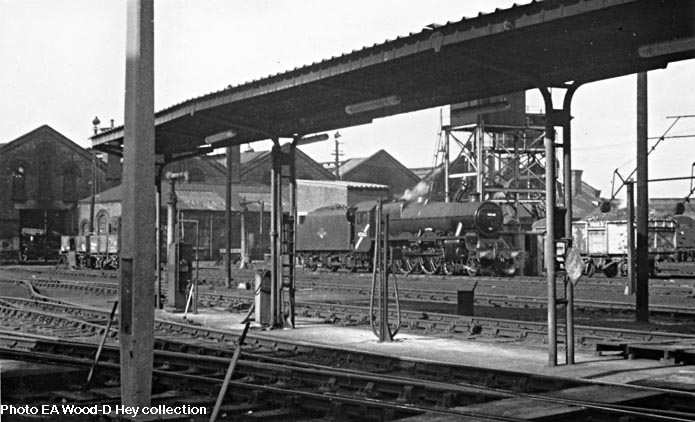
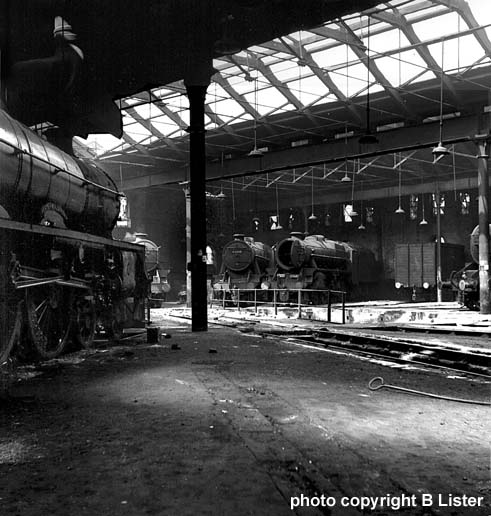
(Above-Inset-Below) One of the best ways of producing a technical artwork is by copying the detail from a photograph. But that raises the question of who owns the copyright - the artist or the photographer? For 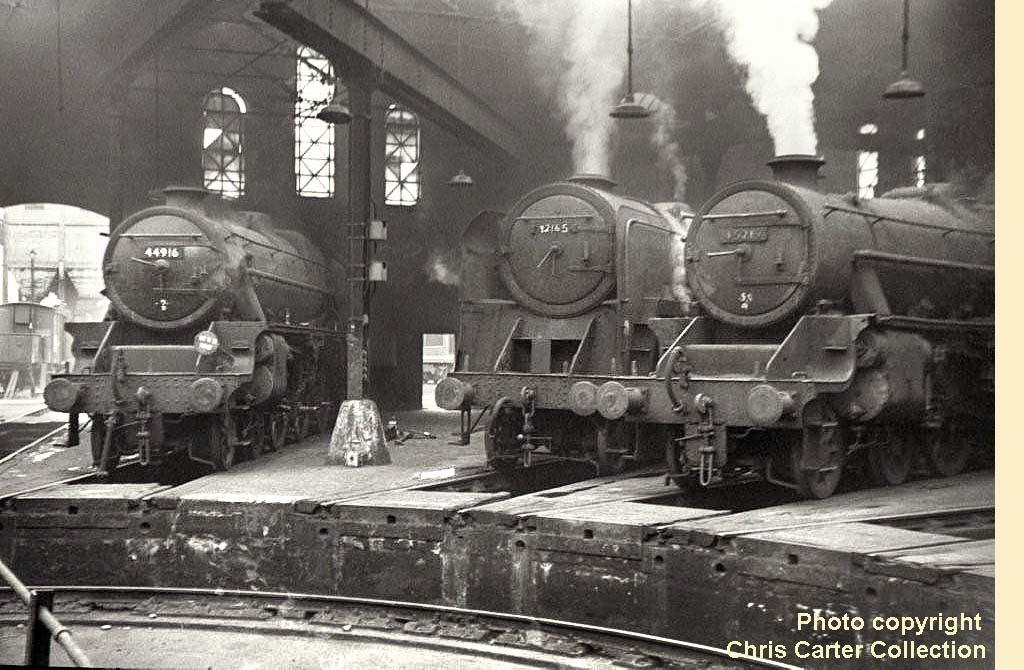 instance, this fine study by Brian Lister of ex-LMS steam inside the roundhouse at Holbeck would make an excellent subject for a painting. Perhaps adding a few more engines in steam might improve the composition, but I doubt if Brian's photograph could be bettered. Taken in July 1967 (in the same year the North Eastern Region was absorbed by the ER) the shed had less than three months to go before closing its doors to steam. 'Jubilee' class No 45568 Western Australia shares the company of three Black 5s around one of the turntables. (Inset) Another evocative interior shot of Holbeck shed with 'Black 5s' Nos 44916 and 45219 cheek to jowel with Class 9F 92165. (Below) A general view of Engine Shed Junction showing a Thompson B1 heading an unidentified train to Leeds (photo taken with a 3X Orange filter) on 17th May 1963.
instance, this fine study by Brian Lister of ex-LMS steam inside the roundhouse at Holbeck would make an excellent subject for a painting. Perhaps adding a few more engines in steam might improve the composition, but I doubt if Brian's photograph could be bettered. Taken in July 1967 (in the same year the North Eastern Region was absorbed by the ER) the shed had less than three months to go before closing its doors to steam. 'Jubilee' class No 45568 Western Australia shares the company of three Black 5s around one of the turntables. (Inset) Another evocative interior shot of Holbeck shed with 'Black 5s' Nos 44916 and 45219 cheek to jowel with Class 9F 92165. (Below) A general view of Engine Shed Junction showing a Thompson B1 heading an unidentified train to Leeds (photo taken with a 3X Orange filter) on 17th May 1963.
(Above-Below) Fairburn 4MT 2-6-4T No 42073 and Stanier 'Black 5' No 45080 inside the roundhouse at Holbeck in 1967. (Below) Another fine study by Brian Lister of LMS steam inside the roundhouse at Holbeck in July 1967. On the left is Ivatt Mogul No 43076, one of 162 locomotives in the class. They were not the best looking locomotives with their very high footplate and stark front ends. More in keeping with LMS styling is the Stanier tapered-boilered Class '8F' (total built 849) and the unbiquous 'Black 5' (total built 842). In this view, No 48158 and No 44943 await their next turn of duty. Photos © B Lister
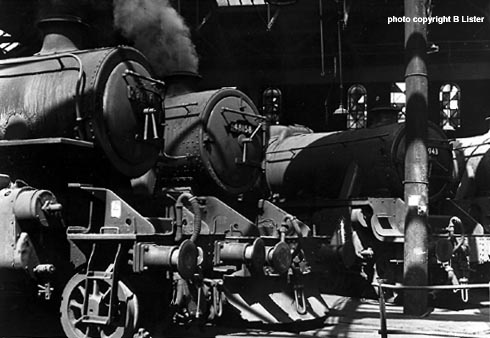

(Above) Had it not been for the announcement of the Modernisation Plan in 1955, the emphasis of which was to replace steam with diesel and electric traction, the 'Britannias' may well have had as long and distinguished careers as some of the 'Big Four' engines they had succeeded. Alas it was not to be. Displaced by diesels on the premier expresses on the Western and Eastern Regions, the entire 55 members of the class were concentrated on the London Midland Region. Withdrawal began in 1966 with No 70007 Couer-de-Lion and 70043 Lord Kitchener condemned in June and August respectively, a mere 14 years after their introduction. The final batch of ten Britannias Nos 70045-54 were coupled to a larger 9 ton capacity BR1D tender which gave a smoother airflow around the footplate than with the conventional tenders with inset sides. The last of the class, No 70054 Dornoch Firth, is being prepared for 'Thames-Clyde' duty.
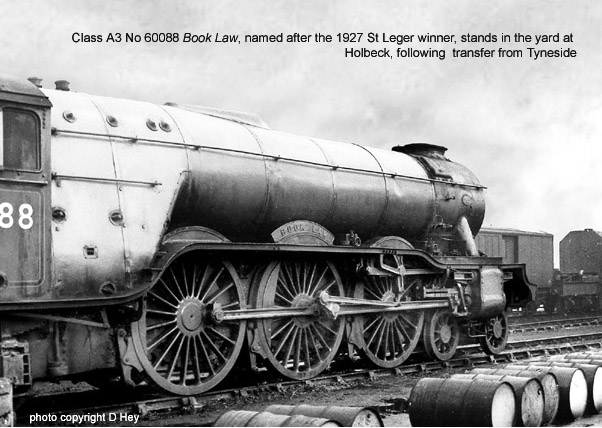
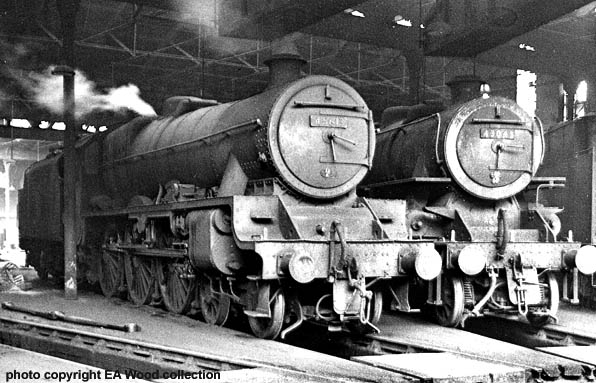
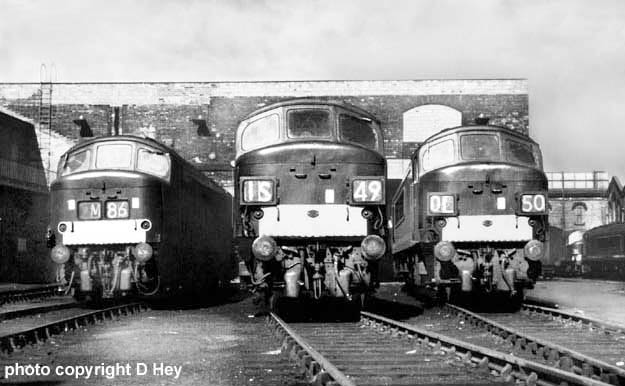
(Above-Below) Before the first 10 pilot scheme 2,300hp Type 4 diesels Nos D1-D10 had been completed, the BTC placed orders for a further 183 members of the class - a hasty decision, but as it turned out the 'Peaks' proved to be one of the more successful locomotives in the fleet. The production 'Peaks' were uprated to 2,500hp by use of charge air cooling, which gave rise to three genetic types of basically similar locomotives - TOPS Class 44 (pilot scheme) and the Class 45 and 46 production locomotives. The 183 production 'Peak' Type 4s were similar in appearance to the pilot scheme locomotives except for front end variations when the gangway doors and aged white headcode discs were abandoned in favour of route indicator panels. This line up at Holbeck show No D152 on the left with its panel centrally placed, while the earlier production 'Peaks' Nos D26 and D29 appear with divided headcode boxes either side of the nose. The reporting number are: 1M86 southbound 'Thames-Clyde Express', 1S49 10.25 Leeds-Glasgow and 0L50 light engine Leeds Division. Note also that Nos D26 and D29 are sporting a Holbeck 55A shed code on their rectangular warning panels. In the shot below, No D30 (later Class 45/0 No 45029) has its shed code plate painted out in yellow as an additional precaution.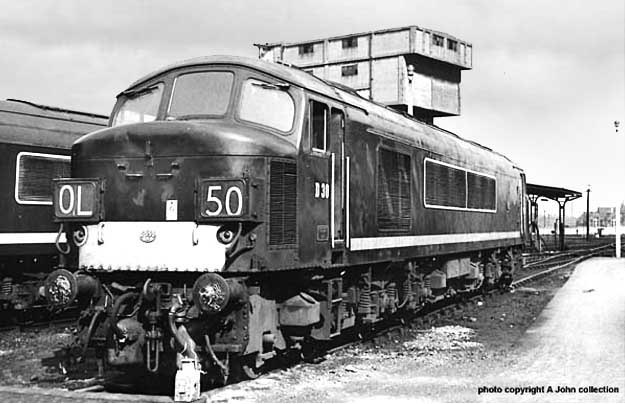
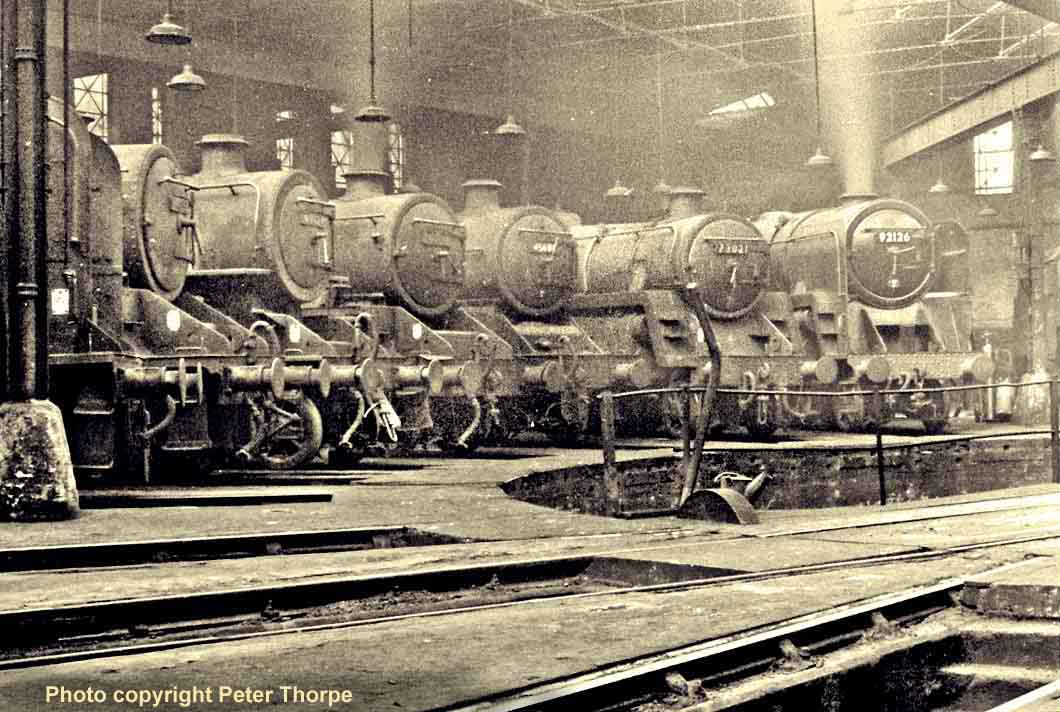
(Above) When Rail Cameraman, Peter Thorpe, visited Holbeck shed on Friday 7 August 1964, the roundhouse was full of engines; from left to right are Class 9F 'Spaceship' No 92160 of 15C Kettering; 'Black Five' 4-6-0 No 44857, 'Flying Pig' 43124 both 55A Holbeck residents, 'Black Five' No 44812 from 21A Saltley, 'Jubilee' 45608 Gibraltar, a 55A Holbeck resident, BR Standard 73021 from Gloucester shed, Class 9F No 92126 from 15C Kettering, and last but not least, 44852, one of Holbeck's many 'Black Fives'.
Despite a childhood dream of becoming a 'Top Link' engine driver, no sooner had I reached school leaving age and my attitude completely changed. I was then a naïve fifteen year-old and the time had come to choose a future career, which to all intents and purposes should have been with BR, but my latest perspective of an engine driver's workplace looked a very different place to the dreamy one I'd nurtured as a boy. How many times as a young spotter had I entered the cavernous space of an engine shed and soaked up the atmosphere? It never occurred to me that I was intruding on someone's workplace, that the old-fashioned scene of lamentable-looking steam engines grouped around the turntable was like visiting an elderly group of geriatric patients waiting at death's door; all around were broken windows and dilapidated roofs, and men in dirty overalls whose working conditions were so dire that I suspect even the most dedicated railwayman found it hard to swallow. The fact is 'reality' trumps 'romance' every time, so when the time came on deciding a future career I looked at every apprenticeships on offer, which, by the early Sixties, were cropping up everywhere. The nation had almost fully recovered from the ravages of WWII and many firms were offering more congenial working conditions than at any other time since the war. Not only were they paying higher wages I was under no illusion about the harsh reality of working on the railway. It was dirty, hard work and BR's decision to get rid of steam was the right thing to do.
(Below) Awaiting attention at Holbeck is 41D Canklow WD 2-8-0 No 90203 displaying a 'Not to be moved sign' on its buffer beam; the WD is standing alongside 'Black Five' No 44828, a long-time Holbeck resident spending over 23 years at the shed up to withdrawal in 1967. The Black 5 is about to receive attention by a cleaner. Peter remembers the employee in this picture complaining about the large amount of ash left on its buffer beam. More photos of Holbeck can be found on Peter Thorpe's excellent 'Rail Cameraman' page. HERE.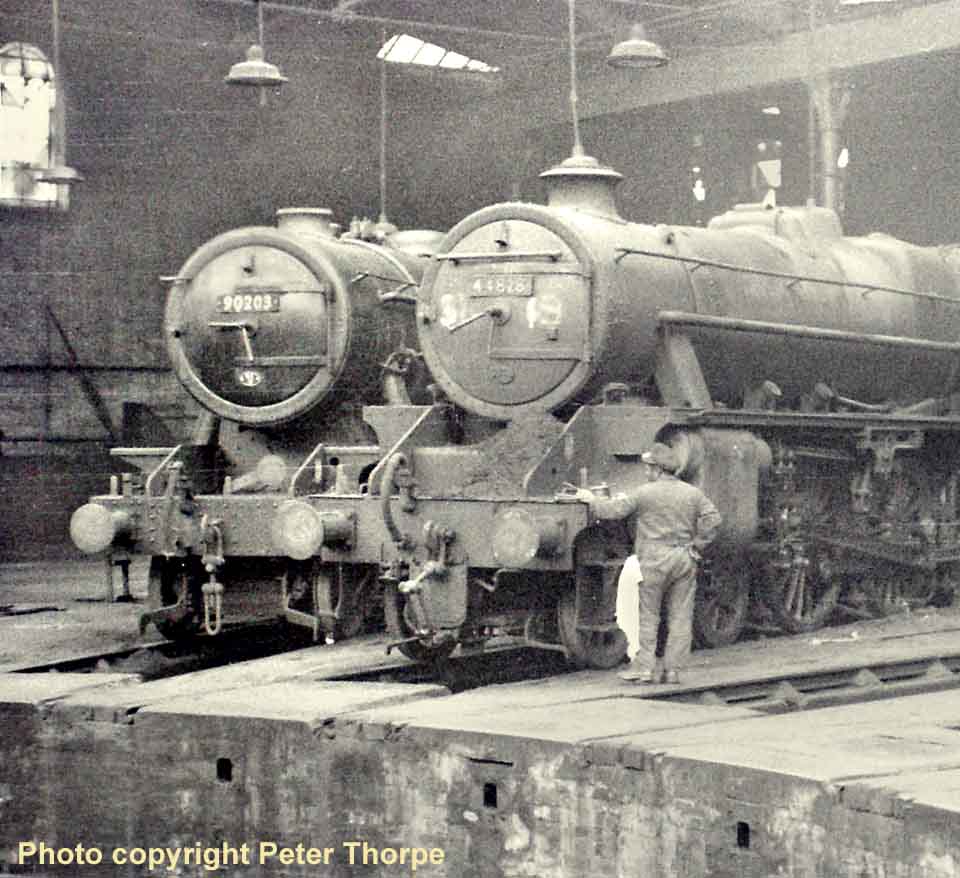
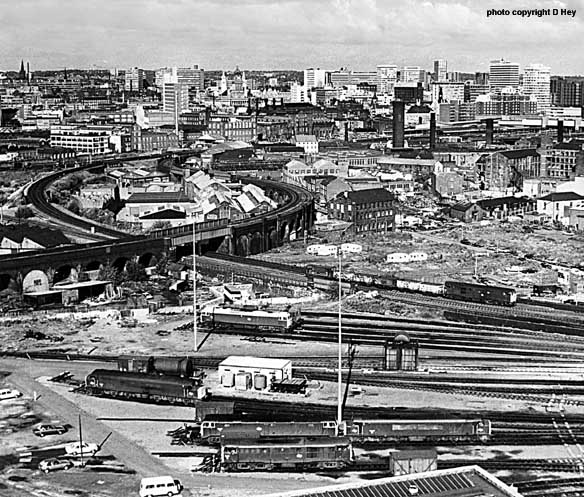
(Above-Below) Britain's city skylines have changed dramatically over the years, and evidence can be found in this view of Holbeck shed yard (taken from the roof of an adjacent block of flats) looking towards Leeds City station in the right background. One day I'll get round to printing a full negative of this shot which clearly show the remains of the shed's two turntable pits filled in with earth and rubble. In the background, the city's once crowning glory - the Town Hall - is now dwarfed by high-rise office blocks, and in the foreground a Class 31 heads an unfitted freight of mineral wagons (complete with an obligatory brake van) past the shed yard towards Stourton. (Below) A glimpse over the wall from Ninevah Road of Holbeck shed during the transition from steam...including a line up of vintage cars!
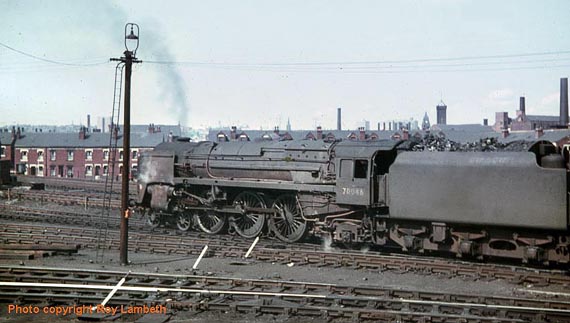
(Above-Inset-Below) While driving through Leeds, Rail Cameraman Roy Lambeth just happened to pass Holbeck shed and snatched a couple of photos over the wall. The unkempt condition of the locos was typical of BR's stock during the final years of steam. (Inset) A nameplate from the BR Standard Britannia  Class 4-6-2 No 70046 Anzac went under the hammer for £8,000 at a great Central Railwayana Auction in April 2011. Built at Crewe and named in September 1959, No 70046 was allocated new to Holyhead in July 1954 and later Crewe North, Longsight, Willesden, Aston, then back to Holyhead again, before being transferred to Banbury and finally Carlisle Kingmoor from where it was withdrawn during the first week of July 1967. It was sold to Campbells, Airdrie on 3 October 1967 The loco takes its name from the Australian and New Zealand Army Corps formed during WW1. (Above) Here Class 7MT No 70046 (minus its Anzac nameplates) heads into the shed yard for the coaling stage.Class 9F 2-10-0 No 92082 coupled to 70046 backs into the yard to get coaled.
Class 4-6-2 No 70046 Anzac went under the hammer for £8,000 at a great Central Railwayana Auction in April 2011. Built at Crewe and named in September 1959, No 70046 was allocated new to Holyhead in July 1954 and later Crewe North, Longsight, Willesden, Aston, then back to Holyhead again, before being transferred to Banbury and finally Carlisle Kingmoor from where it was withdrawn during the first week of July 1967. It was sold to Campbells, Airdrie on 3 October 1967 The loco takes its name from the Australian and New Zealand Army Corps formed during WW1. (Above) Here Class 7MT No 70046 (minus its Anzac nameplates) heads into the shed yard for the coaling stage.Class 9F 2-10-0 No 92082 coupled to 70046 backs into the yard to get coaled.
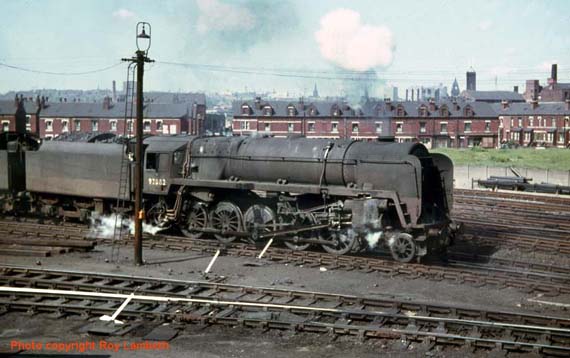
(Above-Below) By the end of the Beeching era the rail network had been reduced to a skeleton of its former self, and disillusioned train spotters didn't have to go too far out of their way to find evidence of BR's decline. The view from the train window became untidily depressing, with hundreds of acres of once-proud Victorian railway buildings and abandoned sidings left to rot. It was almost as if station closures and the removal of track was BR's major occupation during the Sixties. But the misery didn't end there. Rationalisation continued well into the Eighties. When BR abandoned semaphore signalling on the former Midland Railway south of Leeds, I tried to photograph all the signal boxes along the route before they too vanished from the scene. Sadly, by the time I arrived at Holbeck on 1st November 1983, the signal box (Engine Shed Junction) had long since gone and rationalisation of the junction was well underway - it looked like a giant baseboard with bits of Hornby track scattered all over the place! Comparisons can be made with the busy scene (above) taken on 17th May 1963. A Class 4F heads light engine to Stourton, whilst a pair of Class Black 5s, a 'Jubilee' and Class A3 brew up in the shed yard, along with an emerging 'Peak' class. In the background a Trans-Pennine unit crosses the viaduct with a Liverpool-Hull service.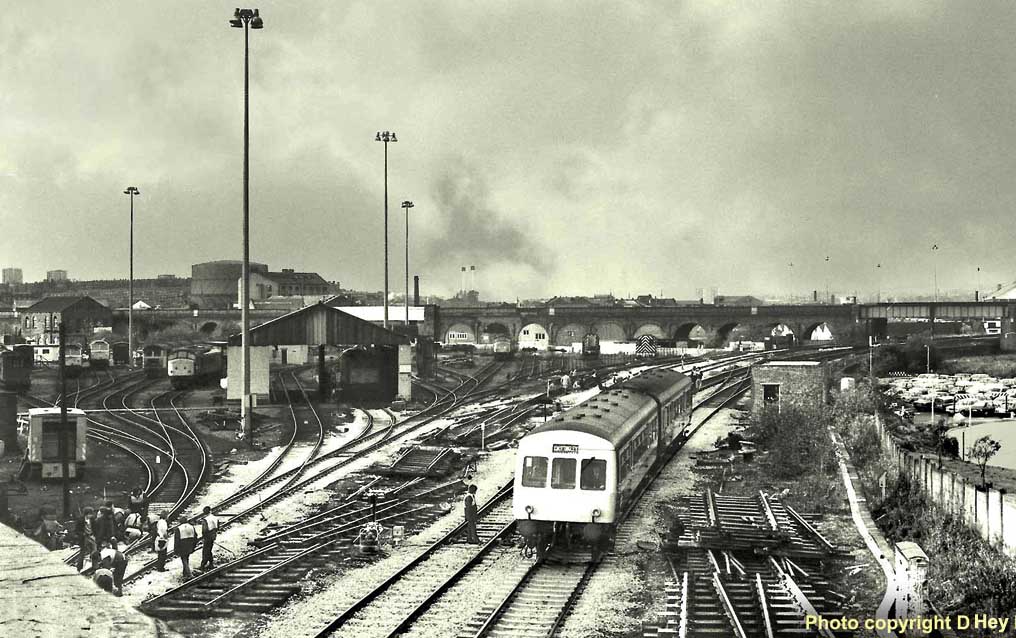
Polite notice: All text and photographs are protected by copyright and reproduction is prohibited without the prior consent of the © owners. If you wish to discuss using the contents of this page the email address is below. Please note - this is not a 'clickable' mail-to link via Outlook Express. You will have to email manually.
dheycollection@ntlworld.com


